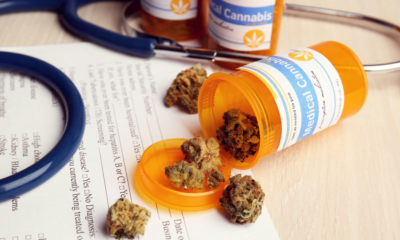In a new extract from the Principles of Cannabinology Handbook, Viola Brugnatelli and Fabio Turco, explore the evidence for, and against, the use of medicinal cannabis in diabetes management.
Diabetes is a complex and pervasive condition characterized by hyperglycemia, or elevated blood glucose levels. There are two primary types:
- Type 1, which results from insufficient insulin production, often due to autoimmune destruction of pancreatic cells;
- Type 2, marked by insulin resistance, where cells become less responsive to insulin, often associated with obesity.
The relationship between cannabis and diabetes is multifaceted and still not fully understood.
This article is an excerpt from The Handbook Principle of Cannabinology by Viola Brugnatelli and Fabio Turco, exploring the potential benefits of Medical Cannabis for those with diabetes.
The diverse impacts of cannabis on diabetes
The impact of cannabis on diabetes is a subject of great interest and debate within the scientific community. The effects of cannabis on diabetes are not solely attributed to its most famous component, tetrahydrocannabinol (THC), but also to a plethora of other cannabinoids with diverse functions. In the current scenario, there are two main perspectives on the use of medical cannabis in diabetes: one in favor, the other opposed.
The evidence against the use of cannabis for diabetes
Increased appetite
Phytoannabinoids like THC, as well as endocannabinoids like Anandamide, can stimulate central CB1 receptors, which are known to increase appetite and lead to weight gain. While this can be beneficial for patients with cachexia or those undergoing chemotherapy, it poses challenges for individuals trying to lose weight, such as those with Type 2 diabetes. This increase in appetite is mainly linked to acute cannabis use and occurs through the stimulation of various physiological pathways, including homeostatic and hedonistic hunger centers.
Endocannabinoid System hyperactivation
Scientific studies have shown that hyperactivation of peripheral CB1 receptors is observed in obese subjects and is correlated with lipogenesis (the process leading to fat accumulation), hepatic steatosis (accumulation of triglycerides in the liver) and insulin resistance, -all important markers in the development of metabolic diseases such as diabetes. Therefore, in conditions such as obesity, the more promising therapeutic approach is not the stimulation of CB1 receptors, as seen with cannabinoids like THC, but rather the inhibition of CB1 receptors. These considerations were highlighted by Rimonabant, a selective central CB1 receptor antagonist, which confirmed the role of CB1 receptor blockade in decreasing body weight and appetite. However, after initial promising results, Rimonabant was withdrawn from the market due to severe neuropsychiatric side effects. This highlights the importance of targeting only peripheral CB1 receptors to avoid these side effects.
The evidence in favor of cannabinoid use
Lower incidence of diabetes and healthy body weight in cannabis users
Multiple epidemiological studies have explored the potential connection between cannabis use and the risk of diabetes. Despite the common association of cannabis with increased appetite, researchers observed that cannabis users displayed a lower likelihood of developing diabetes.
These large-scale studies suggested that while chronic cannabis use may be linked to heightened caloric intake, it does not significantly affect body mass index (BMI). In fact, cannabis users exhibited a reduced prevalence of obesity, even when controlling for variables such as ethnicity, physical activity, and age.
The results challenged the conventional perception of cannabis-induced munchies by indicating that they primarily occur with occasional rather than chronic consumption. Cannabis was found to influence appetite-regulating hormones and metabolic processes in a manner that could contribute to a decreased risk of diabetes. For instance, it has an impact on hormones like ghrelin and affects adiponectin, a hormone that plays a role in blood sugar regulation and body weight management.
Lower insulin and circulating glucose and effects on pancreas
Research conducted at Harvard Medical School and Beth Israel Deaconess Medical Center found that cannabis users had lower fasting insulin and circulating glucose levels. These results suggest that cannabis use may enhance insulin sensitivity, especially during periods of recent use. Moreover, Medical Cannabis, specifically compounds like cannabidiol (CBD), has shown promise in protecting pancreatic β-cells involved in insulin production. In studies involving mice with Type 1 diabetes, CBD reduced inflammatory markers in pancreatic islets, leading to improved insulin and blood glucose levels. Furthermore, CBD demonstrated protective effects against the degeneration of insulin-releasing cells.
Downregulation of the Endocannabinoid System
Studies indicate that obese individuals may exhibit reduced functioning of CB2 receptors. Cannabinoids like tetrahydrocannabivarin (THCV), which activate these receptors, may counteract inflammation related to obesity, offering protection against diabetes. Indeed, THCV, a minor cannabinoid in cannabis, acts as a CB1 receptor antagonist and a CB2 receptor agonist. This dual activity can regulate metabolism, decrease appetite, reduce inflammation, and decrease oxidative stress. Studies have suggested THCV’s potential as a treatment for metabolic syndrome and Type 2 diabetes. Tetrahydrocannabinol acid (THCA), a non-psychotropic cannabinoid and precursor of THC, has also shown promise in reducing fat mass, improving glucose intolerance and insulin resistance, and preventing hepatic steatosis. THCA’s protective effects on the pancreas and the inhibition of fat-stimulating activities make it a potential candidate for diabetes treatment.
Evidence of pathology prevention
Studies involving mice suggest that CBD can significantly reduce the incidence of hereditary diabetes, slow down the onset of the disease, and improve its manifestations. Moreover, it has been observed that CBD can delay the development of Type 2 diabetes in animal models on a high-fat diet.
Cannabis and Diabetes: treating symptoms with cannabinoids
Beyond its potential in diabetes prevention and management, cannabinoids have also shown promise in alleviating symptoms and complications associated with diabetes:
- Cardiomyopathy: Cannabis has been found to protect against the pro-inflammatory cascade responsible for cardiovascular dysfunction due to diabetes. CBD, in particular, has been shown to improve various symptoms of diabetic cardiomyopathy in mouse models.
- Blindness: CBD has demonstrated protective effects against diabetic retinopathy, a leading cause of blindness in working-age adults. CBD therapy has been linked to reduced oxidative stress, prevention of retinal cell death, and decreased vascular hyper-permeability in diabetic retinopathy models.
- Nephropathy: CBD has improved renal problems in patients with advanced diabetic nephropathy, indicating its potential as a treatment option for diabetic kidney complications.
Concluding remarks
Epidemiological evidence suggests that cannabis use may have a neutral or even positive impact on diabetes. While clinical trials are still in the early stages, the potential of cannabinoids like CBD, THCV, and THCA -and other cannabinoid compounds- along with CB1 receptor blockers, CB2 receptor activators, in the management and prevention of diabetes is an exciting area of study.
As research continues, we may see medical cannabis emerge as a valuable tool for healthcare professionals in the fight against diabetes, offering new hope for patients and improved treatment options for this widespread and challenging condition. However, it’s essential to note that further studies are needed to establish the safety and efficacy of these cannabinoid-based treatments fully.
Interested in discovering more?
This article is a valuable excerpt from the Handbook of Clinical Cannabinology by Cannabiscientia SA (you can find all the references to the cited studies in the handbook).
This handbook is a comprehensive guide aimed at supporting European healthcare professionals and anyone eager to understand the medical applications of cannabis in Europe. Merging a plethora of information into one textbook, it offers an extensive overview of the science, regulations, medicine, and the diverse range of products available in the market.
Your path to understanding the world of medical cannabis in Europe begins here. Don’t miss this opportunity to expand your knowledge and expertise in this rapidly evolving field.

 News6 months ago
News6 months ago
 Science5 months ago
Science5 months ago
 Industry6 months ago
Industry6 months ago
 News6 months ago
News6 months ago
 News5 months ago
News5 months ago
 News5 months ago
News5 months ago
 Health5 months ago
Health5 months ago
 Health3 months ago
Health3 months ago












